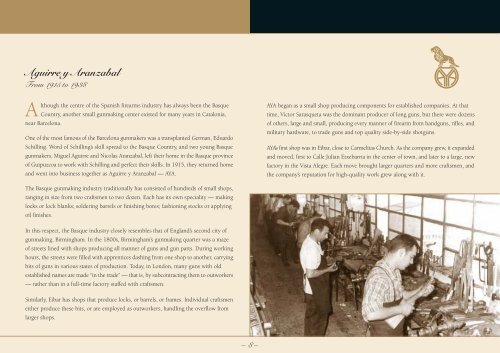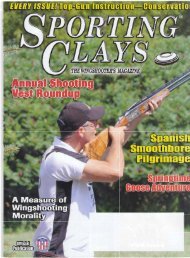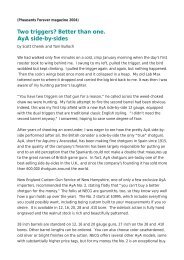. Cat.logo_AYA(1-15).fh8 - AYA, Aguirre y Aranzabal
. Cat.logo_AYA(1-15).fh8 - AYA, Aguirre y Aranzabal
. Cat.logo_AYA(1-15).fh8 - AYA, Aguirre y Aranzabal
Create successful ePaper yourself
Turn your PDF publications into a flip-book with our unique Google optimized e-Paper software.
<strong>Aguirre</strong> y <strong>Aranzabal</strong><br />
From 19<strong>15</strong> to 1938<br />
A<br />
lthough the centre of the Spanish firearms industry has always been the Basque<br />
Country, another small gunmaking center existed for many years in <strong>Cat</strong>alonia,<br />
near Barcelona.<br />
One of the most famous of the Barcelona gunmakers was a transplanted German, Eduardo<br />
Schilling. Word of Schilling’s skill spread to the Basque Country, and two young Basque<br />
gunmakers, Miguel <strong>Aguirre</strong> and Nicolas <strong>Aranzabal</strong>, left their home in the Basque province<br />
of Guipuzcoa to work with Schilling and perfect their skills. In 19<strong>15</strong>, they returned home<br />
and went into business together as <strong>Aguirre</strong> y <strong>Aranzabal</strong> — <strong>AYA</strong>.<br />
The Basque gunmaking industry traditionally has consisted of hundreds of small shops,<br />
ranging in size from two craftsmen to two dozen. Each has its own speciality — making<br />
locks or lock blanks; soldering barrels or finishing bores; fashioning stocks or applying<br />
oil finishes.<br />
In this respect, the Basque industry closely resembles that of England’s second city of<br />
gunmaking, Birmingham. In the 1800s, Birmingham’s gunmaking quarter was a maze<br />
of streets lined with shops producing all manner of guns and gun parts. During working<br />
hours, the streets were filled with apprentices dashing from one shop to another, carrying<br />
bits of guns in various states of production. Today, in London, many guns with old<br />
established names are made “in the trade” — that is, by subcontracting them to outworkers<br />
— rather than in a full-time factory staffed with craftsmen.<br />
Similarly, Eibar has shops that produce locks, or barrels, or frames. Individual craftsmen<br />
either produce these bits, or are employed as outworkers, handling the overflow from<br />
larger shops.<br />
– 8 –<br />
<strong>AYA</strong> began as a small shop producing components for established companies. At that<br />
time, Victor Sarasqueta was the dominant producer of long guns, but there were dozens<br />
of others, large and small, producing every manner of firearm from handguns, rifles, and<br />
military hardware, to trade guns and top quality side-by-side shotguns.<br />
<strong>AYA</strong>’s first shop was in Eibar, close to Carmelitas Church. As the company grew, it expanded<br />
and moved, first to Calle Julian Etxebarria in the center of town, and later to a large, new<br />
factory in the Vista Alegre. Each move brought larger quarters and more craftsmen, and<br />
the company’s reputation for high-quality work grew along with it.




